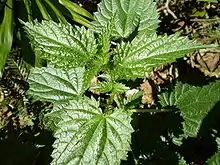Urtica incisa
Urtica incisa, commonly called scrub nettle, stinging nettle, and tall nettle,[1] is an upright perennial herb native to streams and rainforest of eastern and southern Australia, from the north–east southwards through the east, of Queensland and New South Wales, then across the south, through Victoria, Tasmania, south-eastern South Australia and parts of southern Western Australia.[2][3] Also widespread in the North and South Island of New Zealand.[4]
| Urtica incisa | |
|---|---|
 | |
.jpg.webp) | |
| Scientific classification | |
| Kingdom: | Plantae |
| Clade: | Tracheophytes |
| Clade: | Angiosperms |
| Clade: | Eudicots |
| Clade: | Rosids |
| Order: | Rosales |
| Family: | Urticaceae |
| Genus: | Urtica |
| Species: | U. incisa |
| Binomial name | |
| Urtica incisa | |
Growth
Scrub nettle leaves are triangular and opposite, 5–12 centimetres (2.0–4.7 in) long, with serrated margins and stinging hairs.
Uses
Indigenous Australians ate the leaves after baking them between hot stones. They are considered a tasty vegetable, with colonists also using it to make a tonic for "clearing the blood".[5]
References
- "Urtica incisa". Australian Plant Name Index (APNI), IBIS database. Centre for Plant Biodiversity Research, Australian Government, Canberra. Retrieved 5 July 2013.
- "Urtica incisa : Scrub Nettle". Atlas of Living Australia. Australian Government. Retrieved 6 Nov 2013.
- Hyland, B. P. M.; Whiffin, T.; Zich, F. A.; et al. (Dec 2010). "Factsheet – Urtica incisa". Australian Tropical Rainforest Plants (6.1, online version RFK 6.1 ed.). Cairns, Australia: Commonwealth Scientific and Industrial Research Organisation (CSIRO), through its Division of Plant Industry; the Centre for Australian National Biodiversity Research; the Australian Tropical Herbarium, James Cook University. Retrieved 5 Nov 2013.
- "Urtica sykesii". Retrieved 14 May 2017.
- Low, Tim (1988). Wild Food Plants of Australia. ISBN 0-207-16930-6.